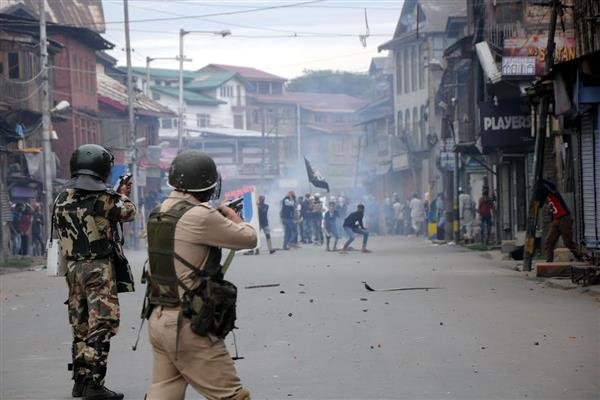Students of my land
The place i live in is too uncertain to live. As a child,as a school going student even.It could be a disturbing experience for one to go through hours of footages watching the school girls throwing stones, being chased by the police screaming at the top of their voice– “Go India, go back.”

In one of the footages, a girl in a black hijab says that they “all are sailing in the same boat.”
“We have the same objective, that our demand should be fulfilled.”
In the following sentence she underscores her objective.
"Presently we have no identity, we are struggling for our identity," she says.
The struggle for "identity" is an ongoing battle in the valley of Kashmir, often described in the media as “Paradise on Earth,” for last several decades and there is nothing new knew in it. What is new– perhaps– is the growing intensity in students' resistance; their resolve to argue and protest.
In another season of limited unrest, however, the young ones of the valley have taken their cause a step further; the school-going girls– like the one in the black hijab– has taken up stones alongside boys and men. They throw stones, not necessarily to hurt anyone, but to register their protest, they said.
First our grand fathers witnessed bloodbath then our fathers and now it’s our time to see our brothers being butchered. How long can we stay as mute spectators," says Shazia (name changed).
But then that students’ protest also has a long legacy in the valley which indeed was more political than personal.
An old man said that he has heard of RRP but unaware of its achievements.
Wishing anonymity, a well known journalist based in Kashmir, researched RRP extensively, gave his reasons for the collapse of what could be described as the first of young men’s movement in the valley.
“It was largely influenced by the rise of the Communists. But Kashmir is largely a conservative place– influenced by Islam– and thus RRP could not spread beyond a point,” he argued. RRP was largely driven by “a section of the intellectuals” and did not spread among the ordinary people– who were largely from the poorer section of the society– and thus the movement had a “speedy death.”
In the next phase, in the 60s, student activism gained momentum in Srinagar. A student in the turbulent 60s, when the student’s movements rocked many countries, M. Saleem Beg, as a young student decided to hit the streets.
Now, ensconced in the southern corner of a second floor building made mostly of wood, a typicality of the valley, Beg researches on the ancient buildings of Kashmir. Formally the convener of Indian National Trust for Art and Cultural Heritage [INTACH], an NGO, Beg said that Kashmir’s struggle “emerged” largely out of students’ movement.
The central theme of student activism in Kashmir was always political,” he recalls.
“We had parties like Plebiscite Front, promoting Right to Self Determination,”
He added that “students’ league and young men's league took the lead in the students’ movement in 1965.”
"Jamaat-i-Islami got activated in student politics and formed a student’s union Jamiat-i- Tulaba in 1968-69," recalls Beg.
In mid- 70s Student activism in Kashmir slowed down - "The young men’s league was converted into Plebiscite front party, students league got diluted when many of them joined mainstream politics." Said Beg.
When the student movement was resurrected– about a two decade back– it was led by Kashmir University Students’ Union [KUSU]
KUSU is an “unofficially official organization,” says one of its founder members, on condition of anonymity. In 2007 KUSU actually came into existence and later was banned in 2009 by university administration.
In an interview, leadership of KUSU, which is now banned, said that they are representing the very sentiment of the people which is “outside the campus on the roads.”
From guerrilla warrior to a political leader, student activism has influenced and shaped resistance politics of Azam Inqilabi. Once the Chairman of the United Jihad Council and Chief Patron of J & K Mahaz-e-Azaadi, Inquilabi said that “Students politics has always played a defining role in Kashmir struggle. It has been part of national resistance movement in many forms like seminars, street politics and discussions in Kashmir.”
The student politics gave rise to influential leaders who dominated Kashmir resistance leadership for decades. “Four generations of Kashmir are result of student activism -From Sheikh Muhammad Abdullah to Yasin Malik all were part of student movements”
“Our fourth generation is the students who are on the streets now, and their activism is a reflection of their inner urge to contribute for their national cause, cause of independence.” he said.
“The state repression is instigating students to come on the streets,” he added.
Speaking on the present situation of students activism and students led protest in Kashmir, President of NSUI Mir Junaid Javid said that there is a “transformation among the student community”
“Earlier the student were not on the streets, throwing stones or raising pro-freedom slogans, now agitated youth has an anger against government, bureaucracy and police,” he said
Choking voices won’t help government, it will add fuel to the fire,” said Junaid. However, he thinks that the allegation to ban KUSU while allowing others to operate is “not right.”
“Everyone should be allowed to run their unions,” Junaid, who is expecting a Congress ticket in the next election,he said.